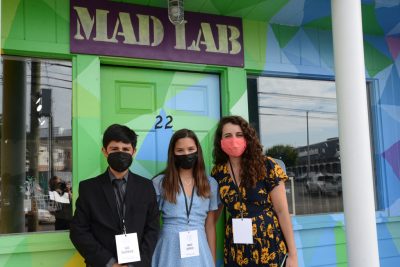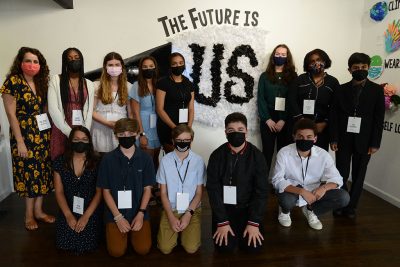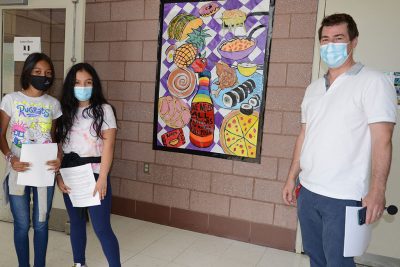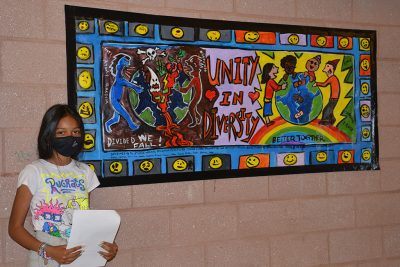
Editor’s Note: The Rogers Educational Innovation Fund awards $5,000 each year to an elementary or middle school teacher in Connecticut who leads an innovative classroom project.
Two innovative art projects funded by the Neag School’s Rogers Educational Innovation Fund, including a photojournalism art exhibit in Norwalk, Connecticut, and a mural project at a middle school in Hartford, Connecticut, brought together middle school students this past spring.
The fund is in place thanks to the support of the late Neag School of Education Professor Emeritus Vincent Rogers and his late wife, Chris, a lifelong teacher. While Professor Rogers wasn’t able to personally enjoy the fruits of the projects his fund supported due to his passing in December 2020, the projects lived on at a middle school and an art gallery.
The Future Is Us
Neag School alumna Jessica Stargardter ’16 (ED), ’17 MA, recipient of the 2019 Rogers Educational Innovation Award, is a gifted and talented educator for Norwalk (Conn.) Public Schools. Stargardter’s project, which involved a group of eight-graders from West Rocks Middle School calling themselves “The Future Is Us,” focused on having students document real-world societal challenges and empowering change in their communities through photojournalism.
“I made the project super student-centered, and the kids have taken so much ownership over their learning.”
— Jessica Stargardter ’16 (ED), ’17 MA
“I made the project super student-centered, and the kids have taken so much ownership over their learning,” Stargardter says. “It’s cool to see how my original vision of the project evolved through their input.”
Initially inspired by a graduate course in human rights and social justice, Stargardter incorporates what she learned in that class with her students. “Everything I do, everything I teach,” she says, “I’ve taken that with me and incorporated those themes into my teaching.”

To start, Stargardter asked the students about their personal passions, pushing them to articulate why particular topics mattered to them.
“We want to highlight how we already are tackling global problems on a larger scale,” the group wrote in their art exhibit opening program. “This exhibit aims to celebrate and gather the Norwalk community and empower others to take action.”
The students started to design the project at the start of the 2020 school year. Together with Stargardter and MAD Lab, a creative hub offering unique physical and digital art space in Norwalk, the students developed the exhibition over six months. It culminated in a gallery showing and community event that was open to the public earlier this summer.
In the beginning stages of the project, one of the students reached out to MAD Lab, which quickly became interested in helping with the project, offering more than a physical space to hold an exhibition.
“Staff from the MAD Lab decided to mentor the students, which has been wonderful,” says Stargardter. “They call themselves creatives, including all different types of artists. They meet weekly with the students and mentor them on where their art should go and how it is being portrayed. We paid for the art space from the grant, but the mentoring was free.”
Students carried the project out throughout the year despite a regularly changing learning model caused by the pandemic. Sometimes they met in person, and sometimes remotely. Most of the students were hybrid, meeting in-person half the time and virtually the other half of the time.
The students were responsible for all aspects of the project, including budgeting, securing the venue, and working with adults on requesting permissions.
“They are so excited, and a little bit stressed at the same time, but in a good way,” Stagardter says. “They were being pushed out of their comfort zone while also helping them realize their strengths. They are learning skills they can apply to real-world situations.”
Ultimately, the exhibit showcased the students’ mixed-media art, Polaroids and photographs, information about local organizations, and activities all focused on five subtopics: climate change, community service, mental health, self-love, and wearing masks. The student artists broke up into groups based on these topics and used the Polaroids to capture how they had been taking action to tackle these global issues.
Stargardter hopes to keep the project going with future students.
“I love how the community has come together,” she says. “It’s amazing to see, despite everyone’s challenges. It’s been cool to see for the kids and for the kids to feel like, ‘Oh, this matters.’”
Community Mural-Making

Jason Gilmore, the recipient of the 2020 Rogers Educational Innovation Award, is an art teacher at Hartford’s McDonough Middle School. Due to the pandemic, his winning proposal for creating a set of murals with students evolved into a virtual project.
“Working virtually this past school year has been challenging, especially for the kids,” says Gilmore.
For one, he says, “we had logistical challenges with securing and locating the supplies in the beginning, along with distributing the kits.”
Through a collective effort involving his family members, Gilmore put together more than 200 art supply kits. Then the effort expanded to the school staff — from the principal to the school secretary to the security guard — who helped distribute the kits to McDonough’s students.
“Some kits were dropped off at the students’ homes if they were not able to come to school,” he recalls. “It became a positive way to reach out to families.”
The art kits, he says, became an incentive for the kids to connect.
“This project, and the support from the Rogers Fund, meant a lot to me.”
— Jason Gilmore
Gilmore’s health issues initially required him to work remotely; as a result, he taught art virtually for part of the year from his basement through Google Meets.
“We looked at mural examples and talked about them, and we talked about various things and topics they cared about,” he says.
At first, some students did not feel confident sharing their art virtually with their peers. Gilmore found a way to resolve that.
“The students had different levels of English skills and different learning styles,” he says. “We used an online tool called Padlet, where the students could share their ideas without identifying [themselves].”
Students came up with themes based on topics they were passionate about and with which felt personal connection: “Celebrating Diversity,” “The Cultural of Food,” and “Celebrating Our Cultures (Hartford/USA, Puerto Rico, Dominican Republic, and Brazil).”

Five of the six murals were painted by the students in Gilmore’s in-person art classes. But when school went virtual, having students paint the larger mural proved to be another hurdle. To connect the students’ concepts in a final product, Gilmore took their ideas and drawings and put them into one composition aligned with the themes. Each class got a printout of the design and filled in the colors to create the final composition.
“I had to rethink art teaching, and expanded the process of community mural-making, something I had not thought of previously,” Gilmore says.
The final product included six painted murals installed at different locations throughout the school:
- Mural 1 “Food is Our Culture” – This mural, designed and painted by eight-grade virtual and in-person students, depicts the Black Lives Matter (BLM) 13 guiding principles. This group chose to focus on black villages, talked at length about their family traditions, and incorporated imagery of different foods as representations of their respective culture and families.
- Mural 2 “Music is in Our Roots” – This mural, designed by eighth-grade virtual students and painted by sixth-grade in-person students, focused on celebrating the students’ family roots. A commonality they depict across all their cultures is music, dance, carnival, and beach culture.
- Mural 3 “Beautiful Things” – This mural was designed and painted by virtual and in-person sixth-grade students focused on the 13 guiding principles of BLM in schools. The class chose to illustrate diversity: “We acknowledge and respect differences and commonalities.”
- Mural 4 “Celebrate Diversity” – This mural designed by eighth-grade virtual students and painted by Gilmore similarly focused on diversity and the 13 guiding principles of BLM in schools.
- Mural 5 “Pathways” – Designed by seventh-grade virtual students and painted by sixth-grade in-person students, this mural addresses the choices that middle school students face every day.
- Mural 6 “Unity in Diversity” – This mural, designed and painted by sixth-grade students, also focused on the 13 guiding principles of BLM in schools. The students worked together to create the statement: “We are better together … we fall when we are divided by our differences.”
For the future, Gilmore hopes the mural program stays — and grows — at the school.
“I want it to become a part of the art program and part of the school’s community outreach programs. I may even make it portable, including providing it for other teachers within this school and teachers at other schools in the community. Hopefully, the mural supplies will become regularly supported.”
Through the mural project, Gilmore says, students were able to develop new skills and relationships, and find new interests in art and or education.
“The project was successful through creative solutions of the whole community with people striving together, traversing barriers,” he says.
Gilmore is proud of the students’ creations and knows they can feel proud about their part in beautifying their community, even under challenging circumstances.
“This project, and the support from the Rogers Fund, meant a lot to me,” says Gilmore. “Just being able to keep focused with this project through being so disconnected from the school and the wonderful kids helped.”
Read more about Gilmore’s project through his blog, “The Mural Intervention Project Part 3,” and view a special message from Dean Jason Irizarry.
 Facebook
Facebook
 Twitter
Twitter
 LinkedIn
LinkedIn
